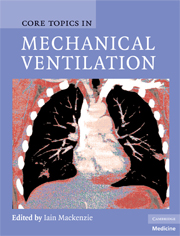Book contents
- Frontmatter
- Contents
- Contributors
- Foreword
- Preface
- Introductory Notes
- 1 Physiology of ventilation and gas exchange
- 2 Assessing the need for ventilatory support
- 3 Oxygen therapy, continuous positive airway pressure and non-invasive ventilation
- 4 Management of the artificial airway
- 5 Modes of mechanical ventilation
- 6 Oxygenation
- 7 Carbon dioxide balance
- 8 Sedation, paralysis and analgesia
- 9 Nutrition in the mechanically ventilated patient
- 10 Mechanical ventilation in asthma and chronic obstructive pulmonary disease
- 11 Mechanical ventilation in patients with blast, burn and chest trauma injuries
- 12 Ventilatory support: extreme solutions
- 13 Heliox in airway obstruction and mechanical ventilation
- 14 Adverse effects and complications of mechanical ventilation
- 15 Mechanical ventilation for transport
- 16 Special considerations in infants and children
- 17 Tracheostomy
- 18 Weaning, extubation and de-cannulation
- 19 Long-term ventilatory support
- 20 The history of mechanical ventilation
- Glossary
- Index
5 - Modes of mechanical ventilation
Published online by Cambridge University Press: 14 October 2009
- Frontmatter
- Contents
- Contributors
- Foreword
- Preface
- Introductory Notes
- 1 Physiology of ventilation and gas exchange
- 2 Assessing the need for ventilatory support
- 3 Oxygen therapy, continuous positive airway pressure and non-invasive ventilation
- 4 Management of the artificial airway
- 5 Modes of mechanical ventilation
- 6 Oxygenation
- 7 Carbon dioxide balance
- 8 Sedation, paralysis and analgesia
- 9 Nutrition in the mechanically ventilated patient
- 10 Mechanical ventilation in asthma and chronic obstructive pulmonary disease
- 11 Mechanical ventilation in patients with blast, burn and chest trauma injuries
- 12 Ventilatory support: extreme solutions
- 13 Heliox in airway obstruction and mechanical ventilation
- 14 Adverse effects and complications of mechanical ventilation
- 15 Mechanical ventilation for transport
- 16 Special considerations in infants and children
- 17 Tracheostomy
- 18 Weaning, extubation and de-cannulation
- 19 Long-term ventilatory support
- 20 The history of mechanical ventilation
- Glossary
- Index
Summary
Introduction
Normal breathing is composed of an infinite range of breaths that vary in depth and timing to suit any and every circumstance from sleeping, yawning or coughing to singing or running. Mechanical substitution of the natural act of breathing could never hope to match what nature has achieved, but within the intensive care ventilator we do have at our disposal a range of breath types that are characterized by properties that fall into two principle domains, those of cycling and inspiratory motive force. The cycling properties of a breath describe what makes the breath start, what makes the breath end and describes the relationship the breath has with other breaths. The inspiratory motive force simply refers to the mechanism the ventilator uses to drive gas into the lungs. Mechanical breaths with specific cycling and inspiratory motive force properties are more suited to some circumstances than others. Ventilator manufacturers bring together one or more breath types, programme the rules by which the constituent breaths interact and thereby define a particular mode of mechanical ventilation. These modes, like the individual breaths, also may be more suited to some circumstances than others, and indeed may result in increased patient comfort, less requirement for sedatives, and even improved outcomes.
Keywords
- Type
- Chapter
- Information
- Core Topics in Mechanical Ventilation , pp. 88 - 114Publisher: Cambridge University PressPrint publication year: 2008

